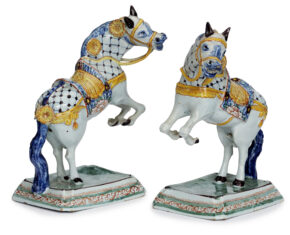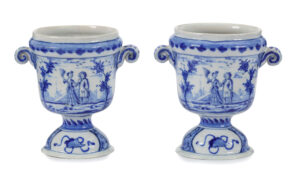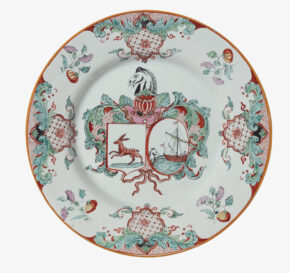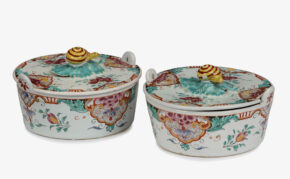![]()
Images on this website are licensed under a
Creative Commons Attribution-NoDerivs 3.0 Unported License.
OBJECT
D2459. Pair of Petit Feu and Gilded Figural Salt Cellars
Delft, circa 1770
The modeled female figure wearing a light blue headscarf atop her black hair, a dress adorned with green and iron red floral decoration accented with yellow and light blue, revealing two black shoe tips, the modeled gentleman wearing an iron-red yellow-buttoned coat over a light blue waistcoat, yellow-red rimed breeches and yellow-red buckled black shoes. Each positioned on a marbled rock on a green ground featuring an ironred rim, each holding a basket with open cover adorned with floral decoration in the same color palette as the dress framed between a double black line.
DIMENSIONS
Width: 19 cm. (7.5 in.)
Height: 17 cm. (6.7 in.)
NOTE
Salt was considered a centerpiece of both the Medieval and Renaissance table top. Through the seventeenth and into the eighteenth century, it remained an important indicator of wealth and status on the dining table. The presentation vessels that contained salt were often sizable and impressive. Figural salts are however rare. Of the figural salt cellars known, often the lady or gentleman is holding one or two basins. One elaborate example of a lady and a gentleman with four basins can be found in the Rijksmuseum, Amsterdam (inv. no. BK-14969). The Kunstmuseum, The Hague has a unique salt cellar that includes a candlestick and mustard jar with a gentleman (inv. no. 0400782). These table pieces were modeled in the latest Rococo fashion, probably after German porcelain examples.
By the early 1740s, sufficient numbers of elegant German porcelain figures, primarily from Meissen, were being imported to the Netherlands. As a result, the Delft factories had little demand for their own less sophisticated versions. However, when the Seven Years’ War (1756-63) erupted, causing interruptions in the production of many of the German porcelain factories, resulting in a severe reduction of the porcelains available in Holland, the Delft factories rose to meet the demand. Many of the resulting figure, animal and bird models produced in Delft during the prolific third quarter of the eighteenth century were based on slightly earlier Meissen models, and while they embrace the spirit of the Rococo Period, they equally exude an underlying earthiness and a characteristic Dutch charm and insouciance.









